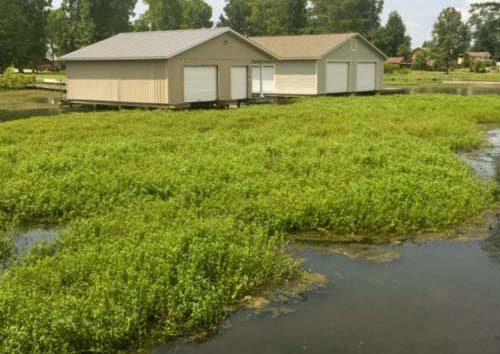Alligatorweed
As alligatorweed (Alternanthera philoxeroides) emerges from both shoreline and near-shore areas in spring, vertical stems provide optimal opportunity for fishing a swimbait or swimjig.

Seasonal Techniques
Spring—As alligatorweed emerges from both shoreline and near-shore areas, vertical stems provide optimal opportunity for a swimbait or swimjig.
Summer—Once alligatorweed reaches the surface, it will begin to rapidly spread out across the water's surface, forming interwoven, impenetrable mats. As stems fall horizontally, new roots can form where leaves previously existed, and quickly root in the sediment. A small white flower will begin to appear at the peak of summer. Once growth increases and mat formation begins, fishing alligatorweed can become quite difficult. Fishing edges is most effective with a jig or senko.
Fall—Alligatorweed will reach peak growth and fishing will remain difficult. Run weedless topwater across and over holes in alligatorweed (heavy braid recommended) or fish edges.
Winter—Dead stems of alligatorweed may be present through mid-winter. Fish these by hopping a jig through and across leftover plant matter.
Habitat Value
Fish—The submersed portions of alligatorweed can provide some habitat for invertebrates, which subsequently become prey for small fish (those fish then become prey for bass). Alligatorweed is notorious for crowding out and shading out beneficial native species.
Waterfowl—There is no known benefit of aligatorweed to waterfowl.
Identifying Features
What It Looks Like—A large, hollow stem and oppositely oriented leaves are characteristic of alligatorweed. A white flower like that of terrestrial clover is also often visible.
Where to Find It—Alligatorweed is highly adaptable and can be found growing on nearly any shoreline out into 5 or 6 feet of water.
Similar Species—Alligatorweed looks very similar to water primrose; however water primrose has alternating leaves, a solid stem and a yellow flower.
Drawbacks
Because of its aggressive nature, invasive alligatorweed very often causes conflict with water uses including making shoreline access impossible. This species is very commonly managed in a reservoir setting. Cost to manage: $$$$ out of $$$$$.
Contact Us
We're always looking for more information about aquatic plants on TVA reservoirs. Let us know where and what you see, and send us your photos. Email us.